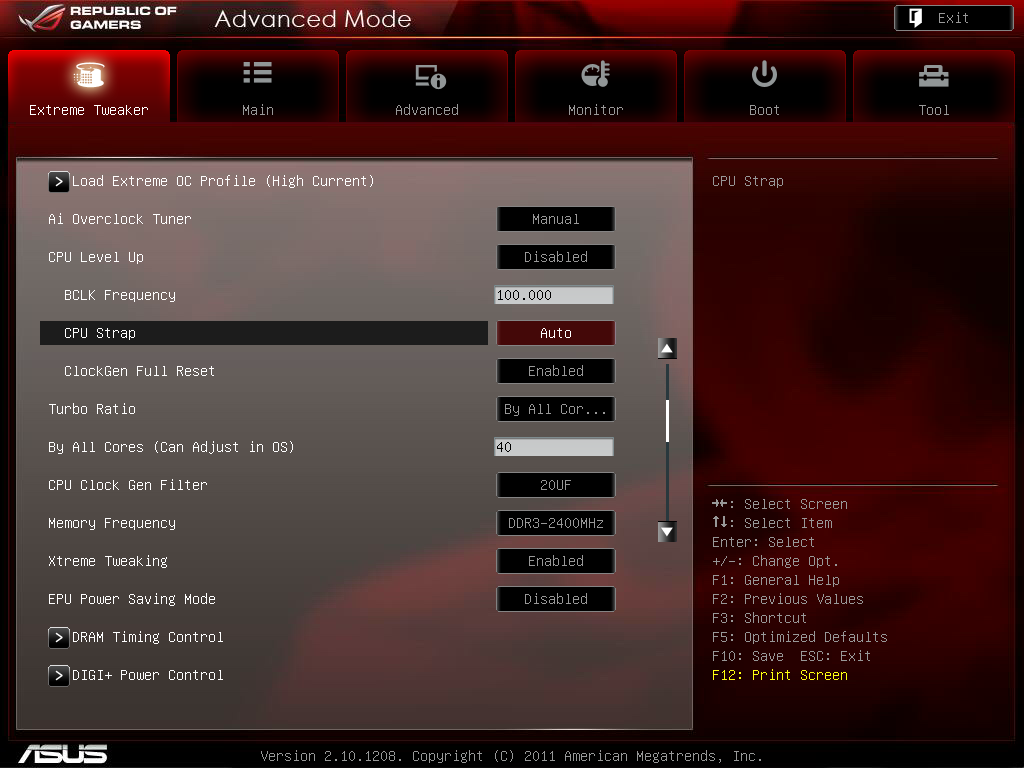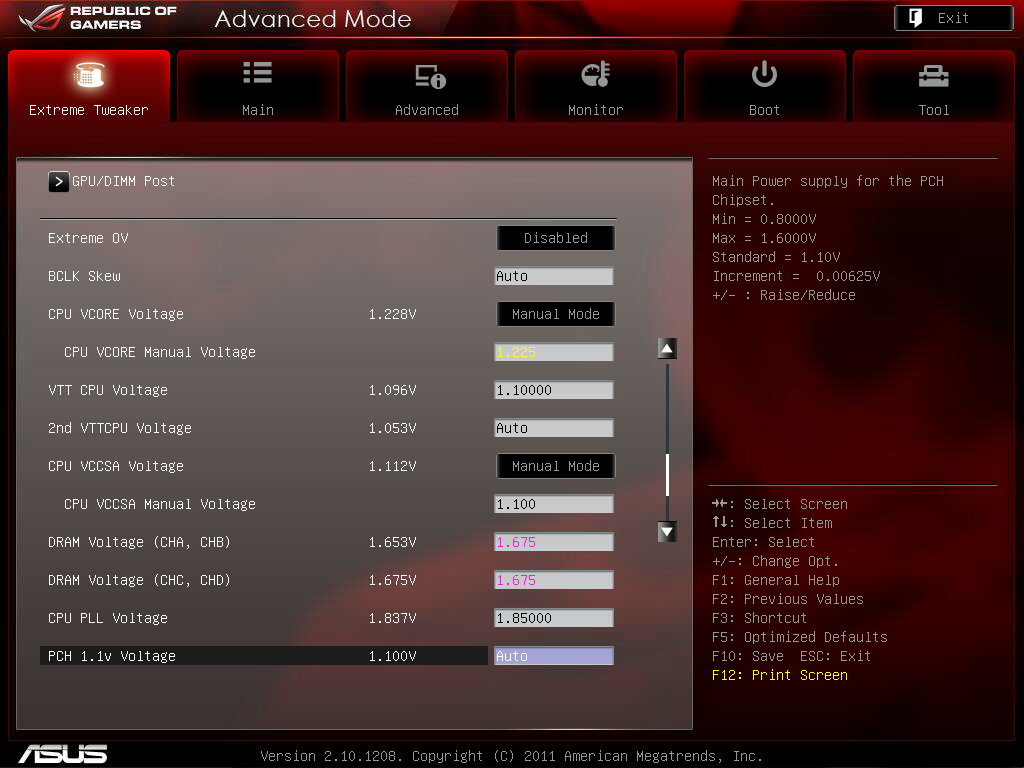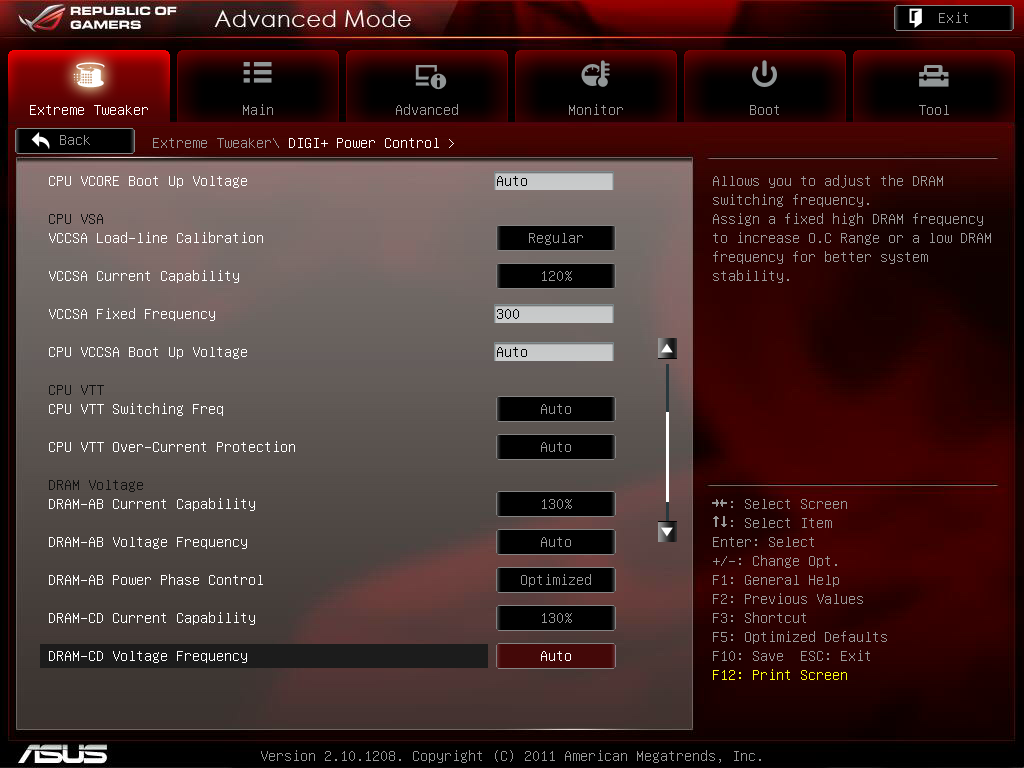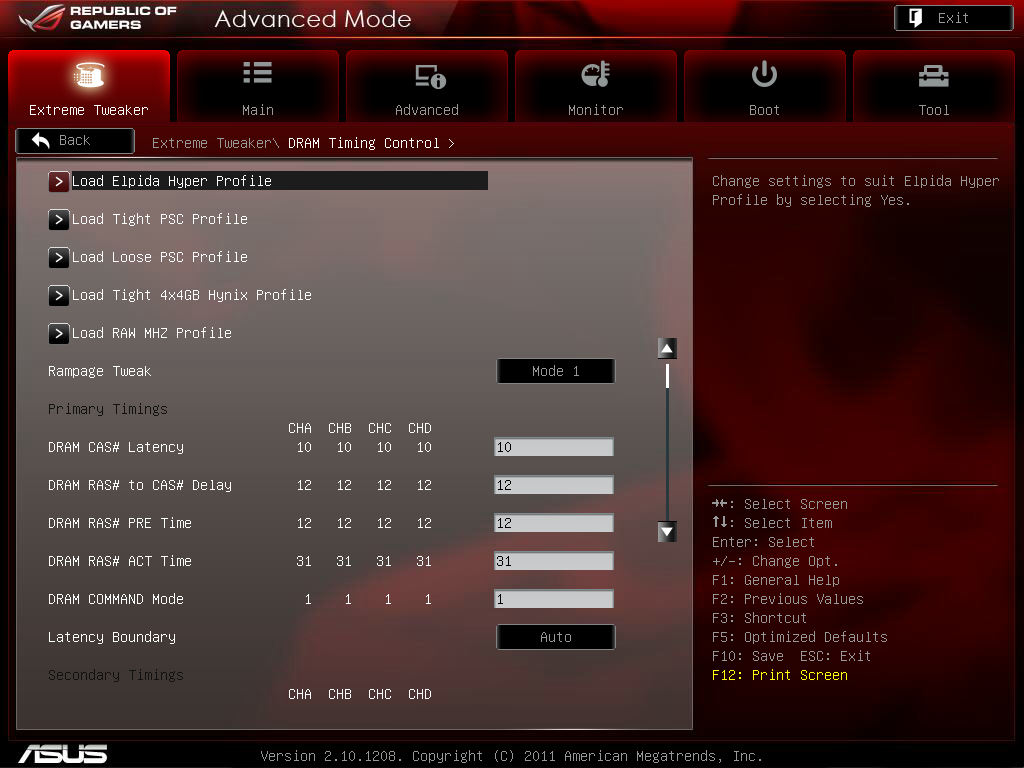As asked for I have put together a brief but hopefully useful overclocking guide for X79 systems.
Firstly lets explain the straps used on X79. Basically there are two usable straps on X79 in the majority of cases. These are the 100 Strap and 125 Strap. If your CPU is on the 100 Strap then BLK directly correlates to bus speed. If your on the 125 strap then BLK will be 125 and bus speed will be 100 thus a divider of 1.25 is applied. So for any given BLK on the 125 strap you must divide the value by 1.25 to give your bus speed. e.g 131 BLK = 105 Bus speed. In all cases CPU frequency is given by multiplier x BLK.
Each strap comes with its own set of memory frequency's also. This must be figured into the equation with any overclocking. The 100 Bus has the usable 1333,1600, 1866,2133 and 2400 memory option while 125 has 1333, 1666,2000,2333mhz usable. So you have 2400mhz memory you can reach that speed using 100 BLK on the 100 strap or using 128.625 BLK on the 125 strap.
This gives flexibility to the end user in terms of CPU, Bus and Memory overclocking.
Lets look at some settings in Bios:

Multiplier set at 40, BLK 100 gives 4ghz. On the 125 strap 40 multi would give 5ghz.
The two interesting options on this first page are Clock Gen full reset and Clock Gen filter. Clock Gen full reset should be set to enable at all times so as when BLK is changed the memory is trained to the changed frequency. This helps a lot with stability. If your benching cold where your CPU has cold bug I would disable this option so the system does not retrain DRAM on blk changes and thus boots with cold bugged IMC.
Clock gen filter helps with high RAM speed clocking and should be set to 10 uf or 20uf for speeds around 2000 - 2400mhz+. This helps with stability as it filters the signal into the RAM when at high frequency. It should be at enable for lower speeds and disable if you mange to get a CPU which boots on the 166 strap.
Xtreme Tweaking gives a touch more DRAM performance so I leave it enabled. I have never noticed a negative impact on stability either with it on.
Further Down the Xtreme Tweaker we see the options for setting voltages:

Always leave Xtreme OV as disabled as even on the cold it need not be switched on and voltage selection is plentiful. Its a good safety measure too for not instantly killing your CPU.
A setting of BLK skew -2 and PCI Ex CLK skew of -20 helps with stability on this format. For cold use -3 and -30 especially with higher BLK. Experiment with these settings -1 and -10 can also work well.
VTT Voltage is the voltage supplied to the PCI EX lanes controller and interconnecting section within the CPU. This setting helps with both DRAM and BLK overclocking. For 24.7 I would not go over 1,2 on this setting ideally 1.15.
VTT2 does not help with overclocking at all but should be kept within 0.4v of VTT so as to ensure Intels spec is maintained.
VCCSA is the IMC volts and helps with DRAM overclocking and stability. VCCSA and VTT should be kept within 0.05v of each other as per Intels recommendations and aid stability. VCCSA should be kept below 1.2v
PLL is interesting on this foramt as what I have fund is on the 100 strap the CPU like around 1.9v and on the 125 strap they like around 1.65v. Experiment with this as getting it right means Vcore down for a certain frequency.
Now lets look at the power settings:

With the heat these CPU's generate on the VRM's and due to heat from the CPU soaking into the socket I never use more than high LLC and for 24/7 no more than medium. Intel design the CPU's with Vdroop in mind so I allow droop to keep temps down under load of both the chip and the VRM extending lifespan of both components at the same time. Also bear in mind VRM heat as well as CPU heat causing throttling on this format.
140 CPU current is enough for everyday. I use 180 for benching. CPU power frequency auto daily, 800 bench. Power Duty control is T.Probe daily and Xtreme for bench with the mos control volts been kept at 7 or lower so as not to create unnecessary heat.
VCCSA LLC is exactly as it says for the memory controller again I dont hammer this as I know high VCCSA will degrade my chip overtime. I want it to droop slightly under load. 120% current gets me 2520 DRAM tight so I dont use more.

I then raise the current and optimise power supply to the DIMMS for improved DRAM overclocking and stability. For bench I push this even further as on X79 memory is the main source of instability due to the complexity of quad channel RAM.

In DRAM settings for most the top four settings are all you need. Rampage tweak AUTO sets second and thirds as XMP. Mode 1 sets compatible second and third timings and can help with stability problems and reaching higher DRAM clocks at the expense of performance. Mode 2 sets Tight second and third timings during training and helps with both performance and overclocking at the expense of stability. More voltage is often needed with this one enabled but bandwidth goes through the roof.
Latency Boundary has further effect on the tertiary timings AUTO is as XMP or in line with Mode 1 and Mode 2. Setting nearer tightens the tertiary for performance while further slackens these timings for stability. A setting of further or furthest helps a lot when clocking 32mb in 4 dimms (ie 4 x 8gb) or 8 x 4gb dimms.
When clocking X79 I do so on both straps but I and many others have noticed a BLK of around 129-131 on the 125 strap seems to yeild best results in terms of Vcore needed. This is because the higher BLK is creating less modulation in PLL and thus the CPU has less errors to correct and a "cleaner signal" High BLK along with low PLL is the way to go with most CPU.
With X79 being so complex I cant cover everything here but ask questions and I will cover what the end user feels is important to them.
Firstly lets explain the straps used on X79. Basically there are two usable straps on X79 in the majority of cases. These are the 100 Strap and 125 Strap. If your CPU is on the 100 Strap then BLK directly correlates to bus speed. If your on the 125 strap then BLK will be 125 and bus speed will be 100 thus a divider of 1.25 is applied. So for any given BLK on the 125 strap you must divide the value by 1.25 to give your bus speed. e.g 131 BLK = 105 Bus speed. In all cases CPU frequency is given by multiplier x BLK.
Each strap comes with its own set of memory frequency's also. This must be figured into the equation with any overclocking. The 100 Bus has the usable 1333,1600, 1866,2133 and 2400 memory option while 125 has 1333, 1666,2000,2333mhz usable. So you have 2400mhz memory you can reach that speed using 100 BLK on the 100 strap or using 128.625 BLK on the 125 strap.
This gives flexibility to the end user in terms of CPU, Bus and Memory overclocking.
Lets look at some settings in Bios:

Multiplier set at 40, BLK 100 gives 4ghz. On the 125 strap 40 multi would give 5ghz.
The two interesting options on this first page are Clock Gen full reset and Clock Gen filter. Clock Gen full reset should be set to enable at all times so as when BLK is changed the memory is trained to the changed frequency. This helps a lot with stability. If your benching cold where your CPU has cold bug I would disable this option so the system does not retrain DRAM on blk changes and thus boots with cold bugged IMC.
Clock gen filter helps with high RAM speed clocking and should be set to 10 uf or 20uf for speeds around 2000 - 2400mhz+. This helps with stability as it filters the signal into the RAM when at high frequency. It should be at enable for lower speeds and disable if you mange to get a CPU which boots on the 166 strap.
Xtreme Tweaking gives a touch more DRAM performance so I leave it enabled. I have never noticed a negative impact on stability either with it on.
Further Down the Xtreme Tweaker we see the options for setting voltages:

Always leave Xtreme OV as disabled as even on the cold it need not be switched on and voltage selection is plentiful. Its a good safety measure too for not instantly killing your CPU.
A setting of BLK skew -2 and PCI Ex CLK skew of -20 helps with stability on this format. For cold use -3 and -30 especially with higher BLK. Experiment with these settings -1 and -10 can also work well.
VTT Voltage is the voltage supplied to the PCI EX lanes controller and interconnecting section within the CPU. This setting helps with both DRAM and BLK overclocking. For 24.7 I would not go over 1,2 on this setting ideally 1.15.
VTT2 does not help with overclocking at all but should be kept within 0.4v of VTT so as to ensure Intels spec is maintained.
VCCSA is the IMC volts and helps with DRAM overclocking and stability. VCCSA and VTT should be kept within 0.05v of each other as per Intels recommendations and aid stability. VCCSA should be kept below 1.2v
PLL is interesting on this foramt as what I have fund is on the 100 strap the CPU like around 1.9v and on the 125 strap they like around 1.65v. Experiment with this as getting it right means Vcore down for a certain frequency.
Now lets look at the power settings:

With the heat these CPU's generate on the VRM's and due to heat from the CPU soaking into the socket I never use more than high LLC and for 24/7 no more than medium. Intel design the CPU's with Vdroop in mind so I allow droop to keep temps down under load of both the chip and the VRM extending lifespan of both components at the same time. Also bear in mind VRM heat as well as CPU heat causing throttling on this format.
140 CPU current is enough for everyday. I use 180 for benching. CPU power frequency auto daily, 800 bench. Power Duty control is T.Probe daily and Xtreme for bench with the mos control volts been kept at 7 or lower so as not to create unnecessary heat.
VCCSA LLC is exactly as it says for the memory controller again I dont hammer this as I know high VCCSA will degrade my chip overtime. I want it to droop slightly under load. 120% current gets me 2520 DRAM tight so I dont use more.

I then raise the current and optimise power supply to the DIMMS for improved DRAM overclocking and stability. For bench I push this even further as on X79 memory is the main source of instability due to the complexity of quad channel RAM.

In DRAM settings for most the top four settings are all you need. Rampage tweak AUTO sets second and thirds as XMP. Mode 1 sets compatible second and third timings and can help with stability problems and reaching higher DRAM clocks at the expense of performance. Mode 2 sets Tight second and third timings during training and helps with both performance and overclocking at the expense of stability. More voltage is often needed with this one enabled but bandwidth goes through the roof.
Latency Boundary has further effect on the tertiary timings AUTO is as XMP or in line with Mode 1 and Mode 2. Setting nearer tightens the tertiary for performance while further slackens these timings for stability. A setting of further or furthest helps a lot when clocking 32mb in 4 dimms (ie 4 x 8gb) or 8 x 4gb dimms.
When clocking X79 I do so on both straps but I and many others have noticed a BLK of around 129-131 on the 125 strap seems to yeild best results in terms of Vcore needed. This is because the higher BLK is creating less modulation in PLL and thus the CPU has less errors to correct and a "cleaner signal" High BLK along with low PLL is the way to go with most CPU.
With X79 being so complex I cant cover everything here but ask questions and I will cover what the end user feels is important to them.

